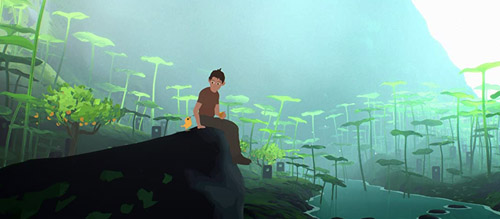Away (2019) Review
Away (2019)
Director: Gints Zilbalodis
Screenwriter: Gints Zilbalodis
Atmosphere, immersion, emotion: the perfect triad to describe Gints Zilbalodis’ feature debut Away. A feeling, a vibe, and a journey is central above character or story, the minimalist plot de-cluttering the filmic transposition and resulting in a calming, sensory experience.
Zilbalodis is the key creative behind the picture, with total possession of the direction, animation, editing, and score – this is the ultimate labour of love. With cinema, especially personal projects such as this, a transcendental outpouring of passion is overwhelming; it is something indescribable, but certainly a feeling. The overwhelming nature of this feeling does not stagger us, but rather complements the tactile behaviour of the sensory brain, welcoming us into an environment rather than having us deciphering a story.
An animation of such evocative immersion uses similar motifs to popular art video games such as the minimalist vibrancy of low poly landscapes in ‘The Witness’; the wispy wandering nodes of ‘Journey’; the bizarro totem, obelisks and creatures of ‘No Man’s Sky’; the adventure, chase and scale of ‘Shadow of the Colossus’. In fact, the nameless character in Away stumbles upon his own inventory – a telescope, map, motorbike, and canteen – the cornerstone of any survival game. After surviving a plane crash, the hero must navigate this bewildering island whilst outrunning a shadowy behemoth. As stated prior, it’s a simple narrative that quickly and effectively sets cogs in motion. When referring to the hero’s map, he has a lengthy task ahead of him, complete with waypoints and checkpoints disguised as alien archways.
Away is also segmented into chapters, each showcasing a different vista on the island, labelled “Forbidden Oasis”, “Mirror Lake”, “Dream Well”, and “Cloud Harbour”. Consistency through pacing, more so than structure, is crucial when compartmentalising the narrative. Typically, one would expect a jolt in immersion when transitioning from one locale to the next, especially in a jarring changeover from an oasis to a snowy hillside, but implementing a simple title-card eases the potentially awkward passages between landscapes without effecting the pacing or tight runtime.
The gentle momentum requires an equally gentle stylistic approach. Environments are euphorically enlightened by delicate cel-shading and a dynamic colour palette. A sweeping, free-moving camera soars behind the protagonist, overtly capturing atmospherically potent territories. These extremely far-reaching angles create a disparate spatial awareness whilst still centralising the lead, and the film’s reverence of scale cannot be touched. Thinking recently, and within popular releases, Pixar’s Onward similarly boasts natural and magical landscapes in outstanding detail but cannot capture the spellbinding scope of Away’s environments. Notably, the nameless lead adopts a small bird on his travels and, once the chick masters flight, it conducts a chunk of the camera’s movement to further the audience engagement and photograph the postcard backdrop of the island.
Sparse melodies populate Zilbalodis’ world. His electronic score, that admittedly sounds orchestral, mixes wonder and looming danger. With no dialogue throughout, the importance of sound is especially vital, so nailing a score with enough emotional nuance to rival spoken words is superb. The crunch of snow underfoot and the panoramic echoing of water droplets in a cave are more noticeable without dialogue to deter these sounds. The soundscape must be able to match the atmosphere created by the visuals, a sensibility heightened by the minimal script work.
To draw filmic comparisons without dismissing Zilbalodis’ work, Away features the same restrained approach of Studio Ghibli co-production The Red Turtle and holds the clear influence of films from Terrence Malick and Hayao Miyazaki. For such influences to be felt so early in Zilbalodis’ career is major praise, but in this first feature the stylistic influences are present if not completely realised. Character design feels especially disjointed in the environments on display; unfortunately mainstream audiences have been conditioned to the detail present in Pixar, or the expressiveness of Studio Ghibli’s work. Often, Away lacks weight. Characters are too floaty and appear to work against gravity, and while it is not too detrimental to enjoying Away, it is noticeable enough to cause distraction. Again, Zilbalodis is such a promising creative that these criticisms are minuscule in comparison to his directing prowess.
Having total creative jurisdiction over a film has its benefits equal to downfalls. Over three years of production seems arduous and sluggish but greater reaffirms the label of ‘labour of love’ and, when the film concludes, a single credit reading “A film by Gints Zilbalodis” perfectly summarises the experience – personal, if isolating. Zilbalodis stated there was no clear-cut direction that the film was taking, nor did he plan how it was going to end. Weirdly enough, the ambling, aimless plotting suits Away’s vibe perfectly, highlighting that the journey is just as important as the ending.
16/24
Purchase this film now via iTunes and Apple TV.
Written by Tommy James
You can support Tommy James in the following places:
Twitter – @TommyJames__
Portfolio – tommy-james.com


